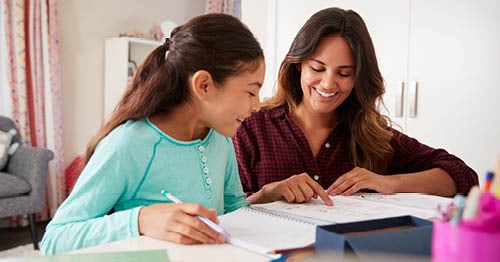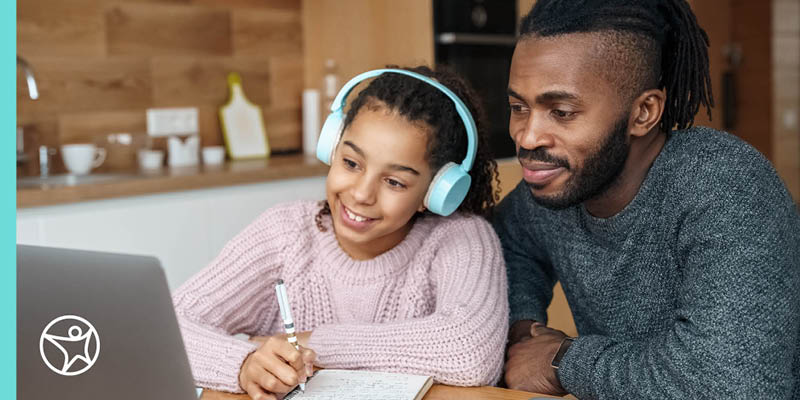Teacher Appreciation Week: How Students Can Say Thank You to Their Teachers
by Julie Hersum
byConnections Academy
5 min to readThere’s no one-size-fits-all plan when it comes to supporting a student in online school, but these habits can help set them up for success:
Learning from home, especially if your student has never experienced full-time online school before, comes with its own challenges. Home is usually the place where your student can relax rather than work, and in their room, surrounded by distractions, can make it difficult to focus on completing their required school hours rather than spending that time wishing they were doing anything else.
Also, the flexible scheduling of online school means that apart from attending LiveLesson® sessions, school can work around your family’s schedule. And first-time students, when left to keeping themselves accountable, can often fall into the habit of starting the school day at inconsistent times or taking longer—and more frequent—breaks.
Just as you want your student to be on top of their assignments and prepared for class each day, you can help them make this a natural part of their daily routine by setting boundaries for them when it comes to their learning space and schedule.
Similar to how brick-and-mortar schools keep the classroom and playground separate, at-home learners should keep the spaces dedicated to play and the spaces dedicated to learning as distinct as possible. While this can be difficult for students who don’t have room to create a separate place, it is possible to establish an effective learning space free from common distractions almost anywhere.
Teaching your kids at home isn’t always easy, but the secret to keeping students focused on their learning is to first create a visual difference to the space and then establish strict rules for what can and can’t be done in that space during school time. Remember: Connections Academy–supported schools are staffed with caring, supportive teachers. You’re not alone!
Work with your student to create these rules, such as staying off their phones during class or how much schoolwork they should complete before going outside to play.
A recent study has shown that creating habits is your brain’s way of using less energy while increasing productivity. By making their morning routines as much of a habit as possible, you can help your student become prepared for their school day rather than letting them work around when they are motivated to work. Schedule consistent review sessions, homework times, and breaks throughout the day so they know what to expect and what is expected of them day-to-day.
Consistency is key!
While you can and should leave yourself room to be adaptable, carving out specific time for learning versus playtime when your student is learning from home is one of the most effective teaching habits for Learning Coaches.
Common bad habits for at-home school parents can include the tendency to do everything for their student whenever something goes wrong. It can be hard to ignore that instinct to fix something when it goes wrong, but one of the best practices for students learning at home is to let them solve their own problems.
At the start of their at-home school journey, Learning Coaches can—and should—help their students learn how to organize their assignments and schedule, navigate their online education portal, reach out to their teachers and counselors, and troubleshoot basic technology problems like connecting to the printer and finding files on their computers.
But once they have a good handle on what they need to do day-to-day, one of the best practices for remote Learning Coaches is to then let them try to solve their own problems first.
Be accessible to them when they really need help, but by letting them try to figure out what isn’t working on their own, they will build a sense of personal responsibility and start the process of becoming self-sufficient.
Stay an active part of your student’s education by understanding their workload and the expectations their teachers have for them, as well as the expectations they have for themselves. Good teaching habits include knowing when their assignments are due and helping them stay on track.
At the start of a new unit in the semester, go over the syllabus with your student and work with them to create a calendar of deadlines or important dates. It can be easy for projects to sneak up on them, and they may still need your help to keep their workload balanced.
By understanding their workload, you can help arrange their extracurricular activities, plan when they will need an early night to get enough sleep before a big exam the next morning, and recognize if they’re falling behind and need help with a particular subject.

The best habits for homeschool teachers, Learning Coaches, or anyone who wants to see their student succeed academically, are to keep learning and keep communicating.
Here on the Connections Academy Resource Hub, there are hundreds of articles dedicated to providing Learning Coaches with vital information. Resources include video tutorials about lessons, learning tools, and Learning Coach responsibilities, as well as instructional support materials and reference materials.
There’s strength in numbers, and while they are no right or wrong answers for developing good teaching habits, we can all learn from each other.
We encourage you to connect with other Learning Coaches to discuss different teaching approaches and habits that have been successful in their households. We have several community-run Facebook groups for this purpose.
Keep in touch with your student’s teachers to create an open dialogue about your student’s academic performance. Have an open mind about whatever feedback they have, and remember that you are on the same team: you’re here to help your student do their best.
Ready to learn more about online school and what teachers can do to help students succeed? Visit our "Quick Guide to Parent, Student, and Teacher Roles in a Virtual School."
